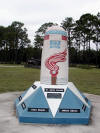 "Voie de la Liberté, 1944" "Voie de la Liberté, 1944"
On prominent display in the
museum memorial garden is a French mile post, a "Borne". Posted near
it is a small placard which reads as follows:
History of the "Liberty Road" and
the Bornes
Soon after WWII, the idea of
establishing a monument by the people of France was suggested, to commemorate
the liberation of France by the American First and Third Armies - a monument
that would be an everlasting symbol of Liberty.
It was then conceived of installing
symbolic milestones, or Bornes, marking every kilometer along the route taken
by the U.S. Armies, to be called "Liberty Road".
"Liberty Road" was the main
route of advance of the U.S.. Armies in their rout of the German Army, and
thereafter it was the main supply route from Cherbourg and Omaha Beach to
Bastogne in Belgium.
Thus, 1146 milestones, (Bornes)
were installed along this "Liberty Road" to commemorate the liberation
of Western Europe. Each Borne is 48" high, 24" in diameter at the base,
tapering upwards to 18" diameter near the top, with a rounded top, and weighing
716 pounds.
The design on each Borne is
identical and represents in a symbolic manner, the flaming red torch of the
Statue of Liberty donated to us by France in 1886, surging from the sea, over
which the American Armies came to Europe. Circling the top part of the
Borne on a blue field, are the 48 stars of the American flag to remind viewers
that men from every state suffered to liberate Western Europe.
This particular Borne, #35, came from the
highway #174 between Utah Beach and St. LO. It was the fourth, and perhaps
final one to be brought to the United States, and was donated to the Camp
Blanding Museum in a special ceremony at St. LO in Normandy on 21 October
1997 by the Prefect (Governor), Department of Manche, and the Mayor of St.
LO.
The reason and significance of this particular
Borne being placed at Camp Blanding is the fact that during the time period
of 1940 & 1943, the 1st, 29th, 30th, 69th and 508th Parachute Infantry Regiments
trained at Camp Blanding for extended periods of time. Then in 1944,
these same units fought side by side in Normandy during the invasion and the
ensuing Battle of Normandy to restore Liberty & Freedom to the people of Normandy,
and thus established what has became to be known as "Liberty Road".
So ir is quite significant that we have
this Borne established here at Camp Blanding as a permanent reminder of the
sacrifices of the men who lost their lives in WWII, establishing
"Liberty Road", the road to FREEDOM!
Contained within the base of this Borne
is an urn holding Earth from each major town and sites along the
"Liberty Road", which was taken from special and
significant places in each town and site:
Utah Beach; St. Mere Eglise; Omaha Beach; Normandy Military Cemetery; St.
Jean-de-Daye; Saint LO; Vire, Mortain; St. James; Brittany Military Cemetery
and Domfront.
These were the most important towns and sites along "Liberty Road", which
were liberated by the Camp Blanding units.
For more details on this Borne, please see
the panel inside of museum
|


